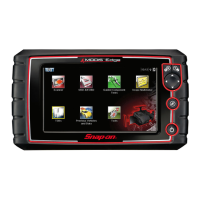93
Scope Multimeter General Reference
5.8 General Reference
5.8.1 Basic Setup Tips (unknown signal type)
When conducting automotive diagnostics, situations may arise when you need to capture and
analyze a signal that you are not familiar with, or know what the intended waveform pattern should
look like, or even how to set the scope to acquire the signal.
The following tips are intended to provide guidance, at the most basic level to assist you in your
lab scope diagnostics.
Testing information and/or procedures for testing certain components may be available in the
Guided Component Test function, see Guided Component Tests‚ on page 101 for additional
information. If you have already narrowed down the system and/or component to test, ID the
vehicle within the Guided Component Test function, and check the available tests first, as this may
save you some time.
If the Guided Component Test function, does not have the test you are looking for, you need to
determine are few thing about what you are testing to get the scope / meter set up to capture a
signal or make a measurement.
i Testing information and known good waveform libraries may also be available from online
sources. Obtaining correct testing reference information can be a key advantage in making sound
repair decisions.
Listed below are a few basic questions to help narrow down the testing direction to follow.
• Are you looking to make or test a simple voltage or current level or maybe check resistance or
continuity? Then you may want to use the DMM.
• Are you looking to check a circuit/component for an erratic dropout or make a frequency test?
You may want to use the GMM.
• Do you need to see signal details (level, shape, frequency etc.)? The lab scope may be the
best choice.
• Are you testing a DC or AC signal?
• What is the operating range of the circuit?
• Do you know what type or shape the intended waveform should be?
After answering the questions above (at a minimum), you need to determine which Scope /
Multimeter test function you are going to use (e.g. Lab Scope, DMM or GMM). See Tests and
Capabilities (Quick Reference)‚ on page 55.
Once your test function is selected, you can now connect the test leads and select the applicable
probe and scales:
Probe (test) type, see Probe (Probe type “test” selection)‚ on page 69
Vertical scale, see Scale (Vertical scale adjustment)‚ on page 66
Sweep scale, see Sweep (Horizontal or Time scale adjustment)‚ on page 67
Connect the test leads or probe, to the applicable test point(s). Always use the correct lead or
probe designed for the test and ensure the signal and ground connections are clean and secure.
For the initial setup, you may wish to turn other channel settings off (e.g. Peak, Filter, Invert, AC
Coupling, Threshold etc.), as these may affect the signal display. See Channel Settings‚ on
page 70.

